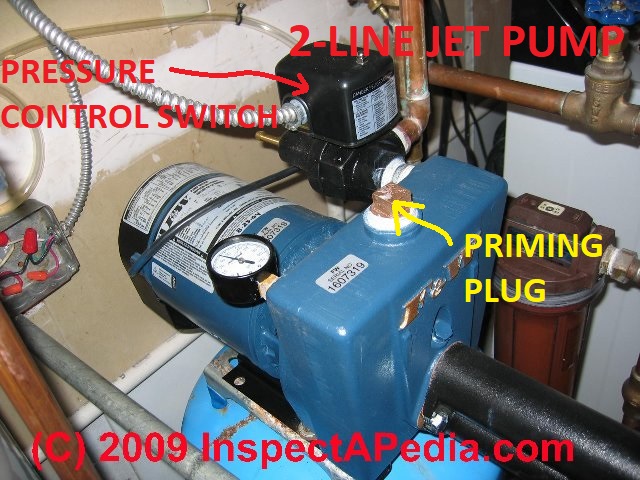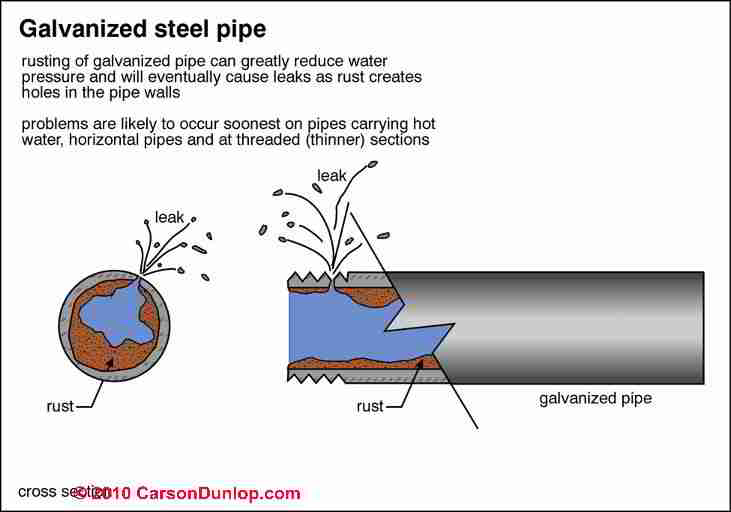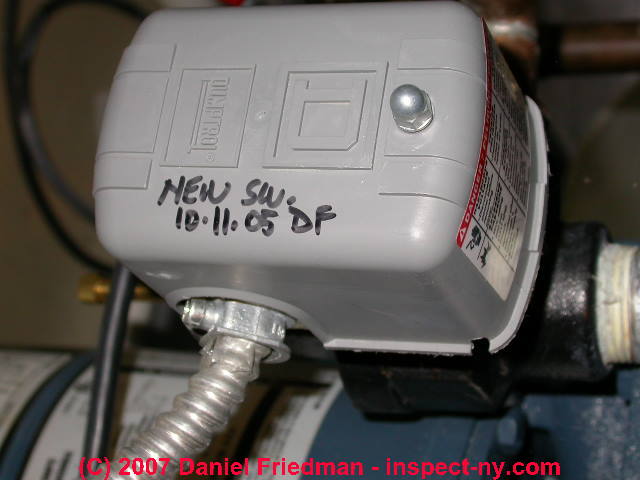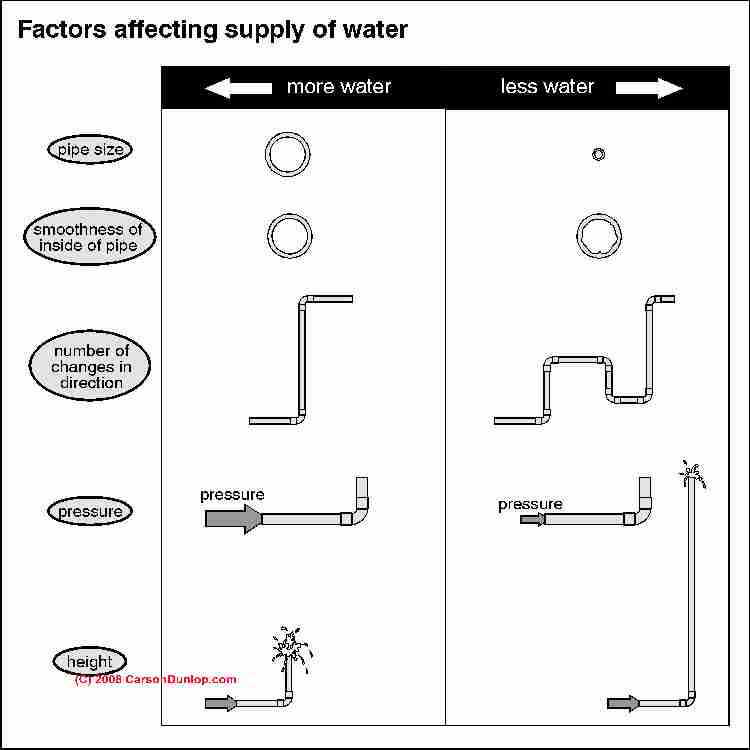 Diagnose & Repair Poor Water Pressure / Lost Well Water Pressure
Diagnose & Repair Poor Water Pressure / Lost Well Water Pressure
Is the problem the water pressure tank?
Is the problem the water pump itself?
13 ways to fix bad water pressure
- POST a QUESTION or COMMENT about how to troubleshoot bad water pressure or no water pressure at all for private well & pump & water tank systems
Private well water problem diagnosis:
How to diagnose poor well water pressure or total loss of water pressure: this article explains how and why to distinguish among intermittent water pressure loss, total water pressure loss, and poor water pressure or flow in a building.
We give diagnostic and repair procedures for both municipal water supply problems and well water supply problems.
The process of diagnosis and the costs of the repair are explained. Consumer advice on saving money on water supply repair costs includes a review of the parts and labor costs of a typical well pump and pressure tank replacement case.
InspectAPedia tolerates no conflicts of interest. We have no relationship with advertisers, products, or services discussed at this website.
- Daniel Friedman, Publisher/Editor/Author - See WHO ARE WE?
How to Diagnose & Correct Poor Well Water or Pump Water Pressure or Flow
 The following articles pertain if you have a private well, pump, and tank system for your building or if your incoming community water supply pressure and flow are just too low to start with:
The following articles pertain if you have a private well, pump, and tank system for your building or if your incoming community water supply pressure and flow are just too low to start with:
- Water Tank Problems?
See WATER PRESSURE TANK REPAIRS. Examples of water tank problems include poor water pressure or the well pump rapidly turning on and off (short cycling). - Water pump problems?
Examples of water pump problems include poor water pressure or no water pressure at all. See - WATER PRESSURE CONTROL SWITCH ADJUSTMENTS - poor building water pressure or flow
- PUMP PRESSURE CONTROL REPAIR - pump is not delivering water at all or water pressure is poor
- WATER PUMP RELAY SWITCH - submersible pump has stopped working
- WATER PUMP PRIMING PROCEDURE - well pump keeps losing prime - pump runs but gives no water
- WATER PUMPS & TANKS & WELLS - complete list of articles
- WATER PUMP CONTROLS & SWITCHES - complete list of well pump controls and switches, identification, diagnosis, repair
- WATER PRESSURE GAUGE ACCURACY - maybe water pressure is fine and it's the gauge that's bad?
- AIR DISCHARGE at FAUCETS, FIXTURES - air is coming out of faucets: is the problem with the pump, piping, or the well itself?
- Poor water pressure or no water pressure after an electrical power loss, lightning strike, or storm?
Water pressure may be lost entirely following a power loss or electrical storm or lightning strike.
Check first for a blown fuse or tripped circuit breaker. A lightning strike can also damage electrical wiring supplying a submersible pump, or it may damage the pump itself.
And less common, a total power failure can sometimes expose a latent problem in the system such as a failing pressure tank bladder or well foot valve.
But always look for the most direct explanation first rather than the more complicated one. So if water pressure fails after electrical power has been lost but then returned, start by looking for an electrical problem.
Watch out: a power surge or lightning strike can on rare occasions trip just half of an un-linked 240-Volt circuit breaker or blow just one of the pair of fuses powering a 240-volt electrical circuit, leaving a pump that runs, but barely, developing only minimal water pressure, or a pump that runs not at all.
An electrician or an experienced well and pump installer can diagnose these conditions by testing the well pump circuit itself, but before calling an expert, just check the fuses and circuit breakers. Thanks to reader EK Woodard for these details.
See details at NO WATER PRESSURE - Water piping or well piping problems between building and well?
If your water pump keeps losing prime, a shallow well jet pump well line could have a bad foot valve - in the well
WELL PIPING FOOT VALVES or there may be a bad check valve on well piping at or near the water tank
or near the above-ground water pump
CHECK VALVES, WATER SUPPLY, DRAINS, PUMPS and so be losing prime.
A leak in the well line piping itself can also lead to loss of prime or to air entry into the piping system
AIR DISCHARGE at FAUCETS, FIXTURES - air comes out at faucets or fixtures - Well Problems?
Do you run out of water or after running water for some interval water pressure and flow are poor? Well problem diagnosis starts
at WELLS CISTERNS & SPRINGS. Leaks in well piping either inside the well itself or between the building and the well bottom can also mean reduced water flow, quantity, and pressure in the building.
See WELL PIPING LEAK DIAGNOSIS.
Before assuming that there is no water in the well, check to see if the water pump is working properly, including loss of pump prime and
a bad or leaky well piping foot valve
See more details at
WATER PUMP PRIMING PROCEDURE
WELL PIPING FOOT VALVES
AIR DISCHARGE at FAUCETS, FIXTURES can also indicate a failing well.
Also see WELL YIELD, SAFE LIMITS
Readers whose wells simply run out of water should
see WELL FLOW TEST PROCEDURE
and see WELL YIELD IMPROVEMENT
And see the diagnostics at NO WATER PRESSURE  Bad water pump or water tank pressure regulator control?
Bad water pump or water tank pressure regulator control?
See WATER PRESSURE REDUCER / REGULATOR (not usually installed on private well and pump systems, often present on municipal water supply systems that use an in-building local water pump and pressure tank to boost pressure).
Before adjusting a well pump pressure control switch
WATER PUMP PRESSURE CONTROL SWITCH, changing building piping, or considering installing a water pressure booster pump
WATER PRESSURE BOOSTER PUMP, it is essential to understand what the incoming water pressure is and exactly why the building water pressure is not satisfactory.
Start at the beginning of this article:
WATER PRESSURE LOSS DIAGNOSIS & REPAIR.
Water pump pressure regulator switch diagnosis and repair steps include these:- How to Adjust Water Pump Pressure:
The detailed, step by step procedure for inspecting and adjusting the water pressure control switch is discussed in detail
at WATER PRESSURE CONTROL SWITCH ADJUSTMENTS. - Diagnosing Water Pump Short Cycling on and off:
If your water pump is clicking on and off too often or quite rapidly
see SHORT CYCLING well or water pumps. - Diagnosing Water Pressure Drops without explanation when the pump stops,
see WATER PRESSURE FALLS SLOWLY, ERRATIC PUMP: bad pressure control switch, building water running or leak, bad pressure gauge, bad check valve, bad foot valve. - Diagnosing & Repairing Lost Air in the Water Tank:
The problem of lost air in the water pressure tank along with how to correct that condition are discussed beginning
at SIGNS OF AIR LOSS in the pressure tank. - Diagnosing & Repairing a Water Pressure Control or Water Pump Control Switch:
We discuss diagnosing and repairing a water pressure control switch that sticks "on" or "off" or simply won't operate,
at WATER PUMP PRESSURE SWITCH REPAIRS
- How to Adjust Water Pump Pressure:
- Bad cold or hot water pressure and flow just at certain plumbing fixtures?
See our discussion
of POOR WATER PRESSURE at JUST SOME FIXTURES  Poor water pressure due to clogged building supply piping?
Poor water pressure due to clogged building supply piping?
Even municipal water supplied in some communities can be "hard" or high in mineral content, iron content, or other ingredients that lead to clogged water piping.
Our sketch (left) courtesy of Carson Dunlop Associates, shows how rust can clog steel water supply piping.
If incoming water pressure is high - say over 40 psi, but water pressure falls off almost immediately when you open a faucet and remains poor, there may be a clog somewhere in your piping system, or worse, in most of it. This condition usually develops over a long time - years - and does not change suddenly on its own.
Readers should also see WATER PIPE CLOG DIAGNOSIS
and WATER PIPE CLOG REPAIR.
Also see WATER PRESSURE LOSS DIAGNOSIS & REPAIR in a building
and see MUNICIPAL WATER PRESSURE DIAGNOSIS
or WELL WATER PRESSURE DIAGNOSIS where we describe the effects of clogged piping on water flow and offer remedies for this problem.
If only hot water pressure and flow are poor, also
see CLOGGED SUPPLY PIPES, HOT WATER.- Small diameter building water supply piping also limits water flow rate:
Even if the municipal water supply pressure is good.
A building using 1/2" diameter piping, especially if the incoming water pressure is modest, or if the building has extensive lengths of water supply piping, perhaps combined with many elbows and tees, will suffer reduced water flow at its fixtures.
A common "fix" for poor building water "pressure" (really flow) where the piping is blamed, is to install larger diameter water supply piping wherever the piping is readily accessible, such as in a basement or crawl area.
As the sketch at left, courtesy of Carson Dunlop Associates shows, installing larger diameter water supply piping helps regardless of where in the piping sequence it is installed - so you don't have to rip out all of the building water piping to make this water flow rate improvement.
Since bad water pressure or flow can be a piping problem rather than a supply quantity problem, also
see PIPING in BUILDINGS, CLOGS, LEAKS, TYPES. - Poor hot water pressure, acceptable cold water pressure at all fixtures? OR poor cold water pressure, acceptable hot pressure at all fixtures?
This condition often indicates clogging in the hot water piping or if a tankless coil is used to make hot water, clogging there.
See CLOGGED SUPPLY PIPES, HOT WATER. Bad Hot Water Pressure?
See HOT WATER IMPROVEMENT especially if the building cold water pressure is acceptable but hot water pressure and flow are poor.
Accumulated debris in a water heater, and debris from a corroded or disintegrating hot water tank dip tube or hot water tank sacrificial anode can also block the hot water outlet opening, resulting in low hot water pressure in a building.
See CLOGGED SUPPLY PIPES, COLD WATER - Bad Cold Water Pressure? blockage in just cold water supply piping - Poor water pressure just at certain plumbing fixtures?

Poor cold water pressure, hot water pressure, or both hot and cold water pressure or flow that is observed just at some plumbing fixtures in a building while flow and quantity are good at others suggests that the water flow or pressure problems are local to certain runs of supply piping or to the specific fixtures.
The sketch at left, courtesy of Carson Dunlop Associates, shows five factors that affect the water pressure and flow in a building. Check the following first:- Clogged aerator or strainer on sink faucets -
clogging by dirt, debris, corrosion, can significantly reduce both hot and cold water flow at a sink where the strainer needs cleaning or replacement.
Unscrew the strainer from the faucet and turn on the water - if the fixture pressure or flow is much better you've probably found the problem.
Look at the aerator/strainer: inspect it, clean it, perhaps soaking it overnight in vinegar to remove corrosion and mineral build-up, or just install a new aerator/strainer. - Broken O-Rings on individual faucets -
can clog the faucet internals and prevent good water flow. If just hot water or just cold water flow is weak at an individual fixture you or your plumber should check for and repair any damaged faucet parts. - Clogs in individual plumbing pipes, valves, elbows -
can occur during construction if copper pipe soldering is not performed properly.
Pushing too much solder into a copper pipe joint can result in weak flow and reduced pressure at all of the fixtures downstream from that fitting, even if the rest of the piping system is in good condition.
You may need help from a plumber to diagnose this problem, but if your water supply piping is not clogging from mineral deposits throughout, and if flow and pressure are bad just at some fixtures, this could be the problem.
Of course if an installer makes this soldering error on copper pipe joints near the beginning of a water supply piping system in a building, all of the fixtures downstream from that point will be affected, possibly all of the fixtures in the building. If mineral clogging might be a problem in the pipes in your building,
see WATER PIPE CLOG DIAGNOSIS
and
see CLOGGED SUPPLY PIPES, COLD WATER
and
see CLOGGED SUPPLY PIPES, HOT WATER
- Clogged aerator or strainer on sink faucets -
- Problems with water treatment equipment can cause loss of water pressure or no water flow:
a clogged water filter, or a malfunction in water disinfection or other water treatment equipment can cause a reduction in water pressure or even a complete stop in water flow in a building.
Also, a water treatment system that uses air injection to remove odors or gases can cause
AIR DISCHARGE at FAUCETS, FIXTURES
Here is an example of a drop in water pressure that may be due to water filter clogging:
Question: We have a well in our home. Can you tell me what to do if we have a lot of black debris that is in our water filter system?
We think this could be why we have poor water pressure. Is there such a thing as a build up of soot or debris that we need to do something to clean the lines?
Answer: Try changing the water filter cartridge. If the problem is eliminated, the filter was clogged.
If a lot of debris has been getting past the water filter, or if the water filter was a late addition to a home that has had a long history of using debris-laden water, pipes, fittings, faucet strainers, and shower heads may be clogged and may need to be cleaned or replaced.
See WATER FILTERS, HOME USE for details about clogged filters, and
see WATER TREATMENT EQUIPMENT CHOICES for our complete list of types of water treatment equipment. - Need a booster pump?
Remote well pumps & pressure tanks, multiple buildings, tall buildings with poor water pressure on upper floors can benefit by a second pump and pressure tank at the upper floors or remote location.
Adding a booster pump can improve building water pressure where the private pump and well system can't get enough pressure or quantity or where the building height impacts water pressure on its upper floors.
See WATER PRESSURE BOOSTER PUMP for details.
...
...
Continue reading at WELL WATER PRESSURE IMPROVEMENT - steps to improve water pressure & flow from a private well water supply, or select a topic from the closely-related articles below, or see the complete ARTICLE INDEX.
Or see WELL WATER PRESSSURE DIAGNOSIS FAQs questions & answers about troubleshooting bad well water pressure posted originally at the end of this page.
Or see these
Recommended Articles
- WATER FLOW RATE CALCULATE or MEASURE - how much water is delivered at a plumbing fixture
- WATER PRESSURE MEASUREMENT
- WATER PUMP CAPACITIES TYPES RATES GPM
- WATER PUMP DRAWDOWN VOLUME & TIME
- WATER QUANTITY IMPROVEMENT
- WELL CLEANING & RESTORATION by GLYCOLIC ACID
- WELL FLOW RATE - how much water can the well deliver
- WELL FLOW TEST for WATER QUANTITY - how to test the well
- WELL LIFE EXPECTANCY - how long will the well last?
- WELL PIPING TAIL PIECE
- WELL YIELD DEFINITION - required well yield & safe well yield
- WELL YIELD IMPROVEMENT - get more water
- WELL YIELD, SAFE LIMITS - safe total well yield, causes of flow rate change
- WELL WATER PRESSURE DIAGNOSIS
Suggested citation for this web page
WELL WATER PRESSURE DIAGNOSIS at InspectApedia.com - online encyclopedia of building & environmental inspection, testing, diagnosis, repair, & problem prevention advice.
Or see this
INDEX to RELATED ARTICLES: ARTICLE INDEX to WATER SUPPLY, PUMPS TANKS WELLS
Or use the SEARCH BOX found below to Ask a Question or Search InspectApedia
Ask a Question or Search InspectApedia
Questions & answers or comments about how to troubleshoot bad water pressure or no water pressure at all for private well & pump & water tank systems.
Try the search box just below, or if you prefer, post a question or comment in the Comments box below and we will respond promptly.
Search the InspectApedia website
Note: appearance of your Comment below may be delayed: if your comment contains an image, photograph, web link, or text that looks to the software as if it might be a web link, your posting will appear after it has been approved by a moderator. Apologies for the delay.
Only one image can be added per comment but you can post as many comments, and therefore images, as you like.
You will not receive a notification when a response to your question has been posted.
Please bookmark this page to make it easy for you to check back for our response.
IF above you see "Comment Form is loading comments..." then COMMENT BOX - countable.ca / bawkbox.com IS NOT WORKING.
In any case you are welcome to send an email directly to us at InspectApedia.com at editor@inspectApedia.com
We'll reply to you directly. Please help us help you by noting, in your email, the URL of the InspectApedia page where you wanted to comment.
Citations & References
In addition to any citations in the article above, a full list is available on request.
- Thanks to Jeneral Sewer Service - George - 845-297-2285, a New York Hudson Valley drain and sewer cleaning and de-clogging expert for technical details and consulting on drain clog diagnosis and repair, including proper use of the Kinetic Water Ram for drain clearing - 3/14/2009
- Thanks to our reader, Carole Cimitile, 2/17/2009, for reminding us that small problems like faucet o-rings, clogged faucet strainers and similar local plumbing fixture defects can have a big impact on hot water flow, cold water flow, or both hot and cold water flow and pressure problems.
- Thanks to reader EK Woodard, Boise State University, Boise ID, for assistance in diagnosing poor water pressure following an electrical power loss. 3/14/2010
- In addition to citations & references found in this article, see the research citations given at the end of the related articles found at our suggested
CONTINUE READING or RECOMMENDED ARTICLES.
- Carson, Dunlop & Associates Ltd., 120 Carlton Street Suite 407, Toronto ON M5A 4K2. Tel: (416) 964-9415 1-800-268-7070 Email: info@carsondunlop.com. Alan Carson is a past president of ASHI, the American Society of Home Inspectors.
Thanks to Alan Carson and Bob Dunlop, for permission for InspectAPedia to use text excerpts from The HOME REFERENCE BOOK - the Encyclopedia of Homes and to use illustrations from The ILLUSTRATED HOME .
Carson Dunlop Associates provides extensive home inspection education and report writing material. In gratitude we provide links to tsome Carson Dunlop Associates products and services.

